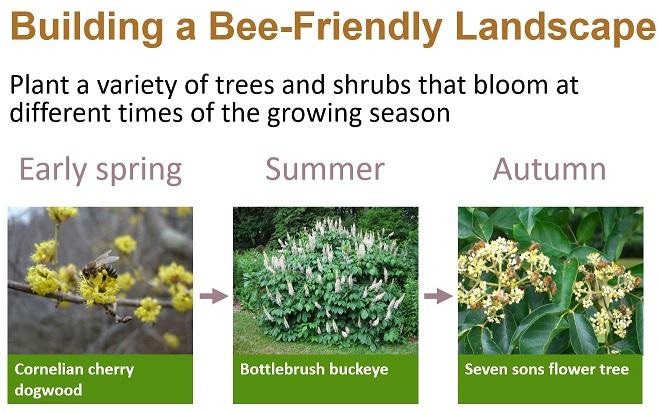Apr 8 2019
Bees are vital constituents in the ecosystem: 75% of the most important food crops depend on pollinators to some extent. Native bee populations, however, have been facing a lot of challenges due to loss of habitat and food, usually caused by urban and suburban development.
 One slide from the Plant Management Network’s open access slideshow on building a bee-friendly landscape. (Image credit: Bernadette M. Mach and Daniel A. Potter, University of Kentucky)
One slide from the Plant Management Network’s open access slideshow on building a bee-friendly landscape. (Image credit: Bernadette M. Mach and Daniel A. Potter, University of Kentucky)
The happy news is that a shrub or single tree can produce thousands of flowers with high-quality pollen and nectar, supplying bees with the carbohydrates and protein they require to survive.
Although several resources persuade land care managers and landowners to develop bee-friendly environments, a majority of them include lists of recommended plants rarely supported by science. As a remedy, Dr Daniel Potter studied 72 native and non-native woody plant species in five sample locations all through the Ohio Valley region to document which species attract which bees. His results, which he reviews in the webcast “Woody Plants for Urban Bee Conservation,” include the following:
- Native as well as non-native plants attract different communities of bees, and non-native plants can prolong the flowering season.
- Flower form is important. Plants that are horticulturally altered for aesthetic reasons, for example, flowers with double petals, do not attract bees.
- Most of the best bee-magnet plants are not attacked by pests, which is appealing to homeowners.
Potter concludes his presentation with a list of the best woody plants and recommendations for developing a bee-friendly landscape. He recommends planting a range of shrubs and trees that blossom at different periods of the growing season—for example, a bottlebrush buckeye for the summer season, a cornelian cherry dogwood that blossoms in the early spring, and a seven sons flower tree for the autumn—to offer critical floral resources through the winter. Other recommendations are available in the webcast.
This 19-minute webcast is a section of a module in the new Pollinators Hub on the Plant Management Network (PMN). The module has a webcast, podcast, summary webcast, study guide, and slide set. PMN is a joint, non-profit resource for the applied agricultural and horticultural sciences. In collaboration with over 80 partners, which include scientific societies, agribusinesses, and land-grant universities, PMN issues quality, applied, and science-based information for practitioners.